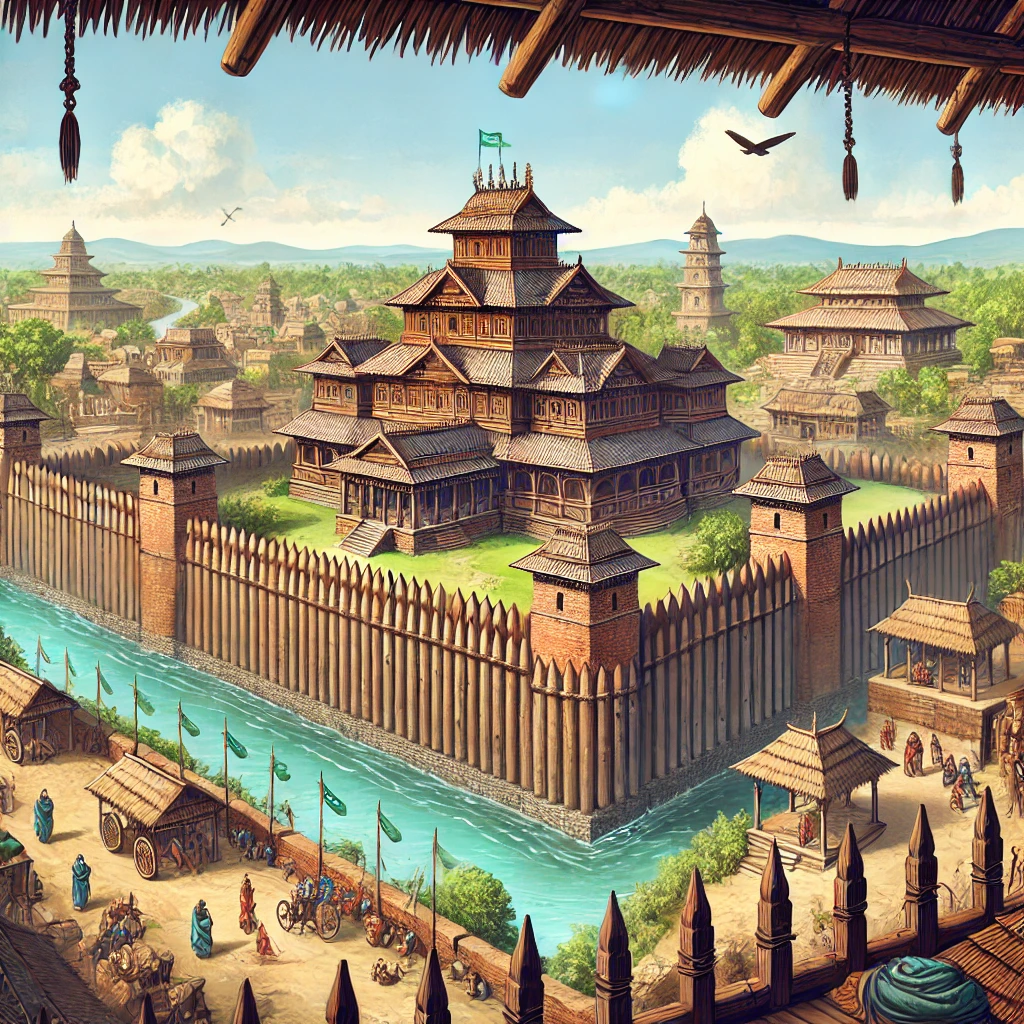Vedic Science Building: Ancient Indian Texts on Construction
Understanding Vedic Science Building
Vedic Science Building is an ancient Indian approach to construction that emphasizes sustainability, resilience, and harmony with nature. This approach is rooted in the rich cultural heritage of ancient India, where construction was not just a technical process, but a sacred art that required a deep understanding of the natural world and the principles of the universe. With this blog, we embark on a fascinating journey through the uncharted pages of history, where ancient wisdom and knowledge await discovery. In this series, we will delve into the treasure trove of ancient Indian texts, unearthing the secrets of Vedic Science Building. In this inaugural blog, we will explore the foundational texts that have shaped the principles and practices of Vedic Science Building, including the Arthashastra, Manasara Shilpa Shastra, Samarangana Sutradhara, and Sthapatya Veda.
Background
As we transition from our introductory exploration into the depth of Vedic Science Building, let us recall our previous journey through this ancient wisdom. In our last series, we brushed the surface of these profound teachings. Now, we delve deeper, drawing connections with the enduring principles that have not only withstood the test of time but also hold potential for modern adaptation.
In our previous blog series, we embarked on a journey to explore the world of Vedic Science Building, examining its rich history, guiding principles, and practical applications. We also emphasized the importance of understanding the cultural and philosophical context of ancient Indian construction, and how this understanding can inform and enrich modern construction practices.
To truly appreciate the significance of Vedic Science Building, it’s essential to delve into the ancient Indian texts that provide the foundation for this approach. These texts, penned by visionary sages and scholars, offer a unique window into the spiritual, philosophical, and technical aspects of ancient Indian construction.
One of the most influential texts is the Arthashastra, attributed to the Indian philosopher and statesman Kautilya (also known as Chanakya). Dating back to the 2nd century BCE, this treatise on statecraft and governance provides valuable insights into the administration of a state, including building construction, accounting, financing, and military affairs. Kautilya’s work is remarkable for its time, demonstrating a profound understanding of the interconnectedness of politics, economics, and architecture.
Another seminal text is the Manasara Shilpa Shastra, written by the Indian sage Manasara in the 5th century CE. This comprehensive guide to the art of building and architecture provides detailed instructions on preparing construction materials, including lime and organic additives. The text also emphasizes the importance of sustainable construction practices, such as using local materials, minimizing waste, and optimizing energy efficiency.
The Samarangana Sutradhara, penned by King Bhoja of Malwa in the 11th century CE, is another significant text that offers insights into the technical and philosophical aspects of Vedic Science Building. This text provides a wealth of information on construction technology, including binder and plaster preparation, building design, materials, and construction techniques.
Lastly, the Sthapatya Veda, attributed to the Indian sage Vikramaditya in the 6th century CE, provides a comprehensive guide to construction technology, including building design, materials, and construction techniques. This text emphasizes the importance of using local materials, minimizing waste, and optimizing energy efficiency in construction.
As we explore these ancient Indian texts, we will gain a deeper understanding of the principles and practices of Vedic Science Building. By examining the cultural, philosophical, and technical context of these texts, we can unlock the secrets of sustainable and resilient construction, and apply these timeless principles to modern building practices.
Arthashastra and Construction Techniques
Building on our understanding of the holistic Vedic framework, we turn our focus to the Arthashastra, a treatise that extends beyond mere statecraft. Kautilya’s insights offer a unique perspective on construction that integrates seamlessly with the administrative and economic fabric of ancient society, embodying the interconnectedness of all aspects of life.
Dated between 2 BCE to the 11th century CE, the Arthashastra is a seminal ancient Indian text that comprehensively outlines the administration of a state, encompassing diverse aspects such as building construction, accounting, financing, military affairs, and weapon manufacturing. Authored by the illustrious Indian philosopher and statesman Kautilya, this treatise on statecraft and governance serves as a vital source of information on Vedic Science Building. Within its pages, the Arthashastra offers profound insights into the construction techniques and materials employed in ancient India, providing a unique window into the country’s rich architectural heritage.
Mortar Preparation and Construction Techniques
In the context of Vedic Science Building, the Arthashastra’s references to mortar preparation and construction techniques are particularly noteworthy. The text describes the preparation of mortar using a mixture of lime, water, and aggregates, such as sand and brick dust. This mixture was then applied to the construction site, where it was used to bind together bricks, stones, and other building materials.
Construction Techniques and Materials
The Arthashastra also describes various construction techniques, including the use of rammed earth, brickwork, and stone masonry. These techniques were used to construct a wide range of buildings, from temples and palaces to houses and fortifications. The text emphasizes the importance of using local materials and traditional construction techniques to create sustainable and resilient buildings.
Practical Applications: The Ancient City of Pataliputra

One of the most impressive examples of Vedic Science Building using Arthashastra’s construction techniques is the ancient city of Pataliputra. Built during the Mauryan period, this city was constructed using a combination of brickwork, stone masonry, and rammed earth. The city’s walls and buildings were designed to be strong and durable, with a sophisticated drainage system and a complex network of roads and alleys.
The Arthashastra’s references to mortar preparation and construction techniques provide valuable insights into the principles of Vedic Science Building. By studying these techniques and applying them to modern construction practices, we can create buildings that are not only sustainable and resilient but also rooted in the rich cultural heritage of ancient India.
Manasara Shilpa Shastra and Construction Materials
rom the strategic outlines of the Arthashastra, we transition to the detailed architectural wisdom of the Manasara Shilpa Shastra. This text shifts our discussion from the broader governance implications to the specific artistry and materials of construction, offering a granular view of ancient building practices.
The Manasara Shilpa Shastra is another significant ancient Indian text that provides valuable insights into Vedic Science Building technique. This text, which dates back to the 5th century CE, is a comprehensive guide to the art of building and architecture. In the context of Vedic Science Building, the Manasara Shilpa Shastra’s instructions on preparing construction materials are particularly noteworthy.
Preparing Construction Materials: Lime and Organic Additives
The Manasara Shilpa Shastra provides detailed instructions on preparing construction materials, including lime and organic additives. The text describes the process of slaking lime and mixing it with organic additives, such as plant fibers and oils, to create a strong and durable mortar. This mortar was then used to bind together bricks, stones, and other building materials.
Sustainable Construction Practices in the Manasara Shilpa Shastra
The Manasara Shilpa Shastra emphasizes the importance of sustainable construction practices, including the use of local materials, minimizing waste, and optimizing energy efficiency. The text encourages builders to use natural materials, such as wood, bamboo, and earth, and to design buildings that are in harmony with their surroundings.
Practical Examples: The Konark Sun Temple

A practical example of the use of sustainable construction practices in ancient Indian construction is the Konark Sun Temple. Built in the 13th century CE, this temple is a masterpiece of Vedic Science Building. The temple’s intricate carvings and sculptures were made possible by the use of lime mortar and organic additives, which were mixed and applied according to the instructions provided in the Manasara Shilpa Shastra. The temple’s design and construction also reflect the principles of sustainable construction practices, including the use of local materials and the optimization of energy efficiency.
The Manasara Shilpa Shastra offers a treasure trove of knowledge on Vedic Science Building, providing detailed instructions on preparing construction materials and emphasizing sustainable construction practices. This ancient text serves as a practical guide, providing formulae and technical guidance that can be applied to modern construction practices. By studying the Manasara Shilpa Shastra and integrating its principles into contemporary building methods, we can create structures that not only embody the essence of sustainability and resilience but also proudly reflect the rich cultural legacy of ancient India, bridging the past with the present.
Samarangana Sutradhara and Sthapatya Veda
As we move from the meticulous guidance of the Manasara Shilpa Shastra, we encounter the Samarangana Sutradhara and Sthapatya Veda. These texts expand our exploration into the technical intricacies and spiritual dimensions of Vedic architecture, bridging philosophical concepts with practical building techniques.
The Samarangana Sutradhara and Sthapatya Veda are two ancient Indian texts that provide valuable insights into Vedic Science Building construction techniques. These texts offer a wealth of information on construction technology, including binder and plaster preparation, building design, materials, and construction techniques.
Binder and Plaster Preparation using Natural Materials
The Samarangana Sutradhara, written by Bhoja in the 11th century CE, describes the preparation of binders and plasters using natural materials. The text outlines the process of mixing lime, water, and aggregates, such as sand and brick dust, to create a strong and durable mortar. The text also describes the use of natural additives, such as plant fibers and oils, to enhance the strength and durability of the mortar.
Sthapatya Veda’s Comprehensive Guide to Construction Technology
The Sthapatya Veda, on the other hand, provides a comprehensive guide to construction technology, including building design, materials, and construction techniques. This text, which dates back to the 6th century CE, offers a detailed guide to the construction of buildings, including temples, palaces, and houses. The text emphasizes the importance of using local materials, minimizing waste, and optimizing energy efficiency in construction.
Practical Examples: The Ancient City of Mandu

A remarkable example of the effective use of natural binders and sustainable construction practices in ancient Indian architecture is the historic city of Mandu. Constructed in the 14th century CE, this city showcases the exceptional skill and ingenuity of ancient Indian builders. Notably, the city’s iconic structures, including the celebrated Jahaz Mahal, were built using natural binders and plasters, demonstrating a deliberate focus on energy efficiency and waste minimization.
The Samarangana Sutradhara and Sthapatya Veda offer valuable insights into the principles of Vedic Science Building technology. By studying these texts and applying their principles to modern construction practices, we can create buildings that are not only sustainable and resilient but also rooted in the rich cultural heritage of ancient India.
Reflections on Vedic Science Building Technology
In reflecting on the teachings from the Arthashastra, Manasara Shilpa Shastra, and the Samarangana Sutradhara and Sthapatya Veda, we see a tapestry of knowledge that is both vast and detailed.
In conclusion, the ancient Indian texts explored in this blog provide a wealth of information on Vedic Science Building, including construction techniques, materials, and philosophies. By studying these texts and applying their principles to modern construction practices, we can create buildings that are not only sustainable and resilient but also rooted in the rich cultural heritage of ancient India. As we move forward in our exploration of Vedic Science Building, we will continue to draw on the wisdom of these ancient texts, and to explore their relevance to modern construction practices.
Call to Action
We invite you to join us on our journey of discovery of one of the least known sciences contained in the Vedas, the most ancient texts in the world.
To learn more:
- Explore ancient Indian texts and their applications in modern construction
- Research sustainable building projects that incorporate Vedic principles
- Share your thoughts on social media
- Stay tuned for upcoming blog posts
Together, let’s uncover the secrets of Vedic Science Building and create sustainable, resilient, and culturally rich buildings.
Feature Image: Click here to view the image.
Visit our YouTube Channel by clicking here.
Here are the related video links related to the subject:
Click here to visit the related page on Medium.com
Follow us on our social median handles
Glossary of Terms
1. Arthashastra: An ancient Indian text on statecraft and governance, attributed to Kautilya.
2. Manasara Shilpa Shastra: An ancient Indian text on architecture and construction, attributed to Manasara.
3. Samarangana Sutradhara: An ancient Indian text on architecture and construction, attributed to King Bhoja of Malwa.
4. Sthapatya Veda: An ancient Indian text on architecture and construction, attributed to Vikramaditya.
5. Vedic Science Building: An ancient Indian approach to construction that emphasizes sustainability, resilience, and harmony with nature.
6. Shilpa Shastra: An ancient Indian term for the science of architecture and construction.
7. Sthapatya: An ancient Indian term for architecture and construction.
8. Vastu Shastra: An ancient Indian term for the science of architecture and construction, emphasizing harmony with nature.
9. Natural binders: Materials used to hold building materials together, such as lime mortar.
10. Sustainable construction practices: Building methods that minimize environmental impact and promote energy efficiency.
11. Rammed earth: A construction technique that uses compacted earth to create walls and buildings.
12. Brickwork: A construction technique that uses bricks to create walls and buildings.
13. Stone masonry: A construction technique that uses stones to create walls and buildings.
14. Lime mortar: A mixture of lime, water, and aggregates used to bind building materials together.
15. Organic additives: Natural materials, such as plant fibers and oils, used to enhance the strength and durability of mortar.
Top #Tags: #VedicArchitecture #SustainableBuilding #AncientIndianTexts #TraditionalConstruction #Arthashastra
Bibliography
1. Arthasastra. (Translated by R. Shamasastry). Bangalore: Government Press, 1915.
2. Architecture of Manasara. (Translated by Prasanna Kumar Acharya). Delhi: Low Price Publications, 2018.
3. Samarangana Sutradhara. (Translated by Sudhakar Malaviya). Varanasi: Chaukhamba Surabharati Prakashan, 1981.
4. Sthapatya Veda. (Translated by Vikramaditya). Delhi: Motilal Banarsidass, 2018.
Additional Resources
- Arthasastra English Translation By R Shamasastry
- Architecture Of Manasara By Acharya, Prasanna Kumar
- Samarangana Sutradhara By Sudhkar Malaviya 1981 Benaras Chaukhamba
- Sthapatya Veda



Leave a Reply